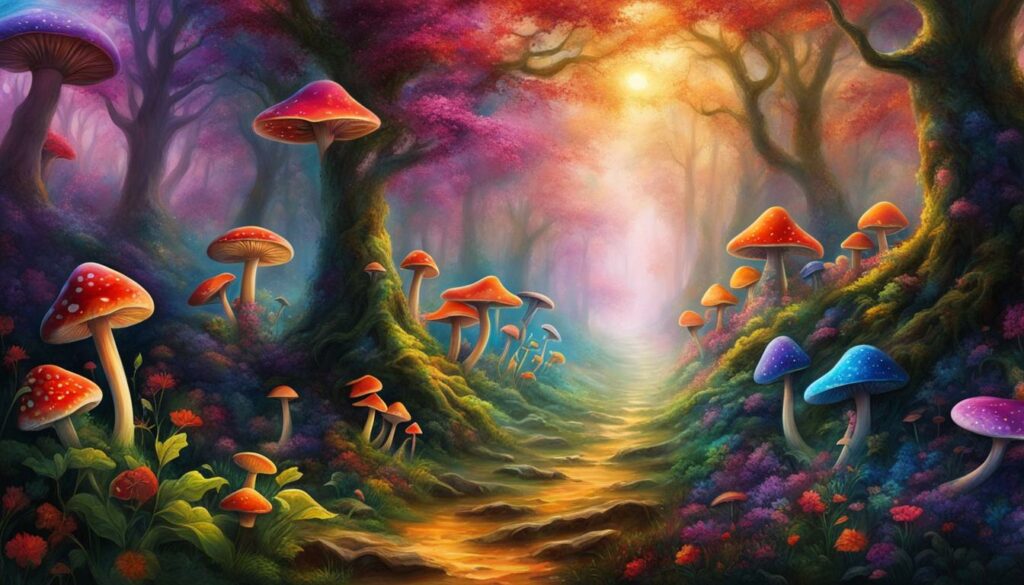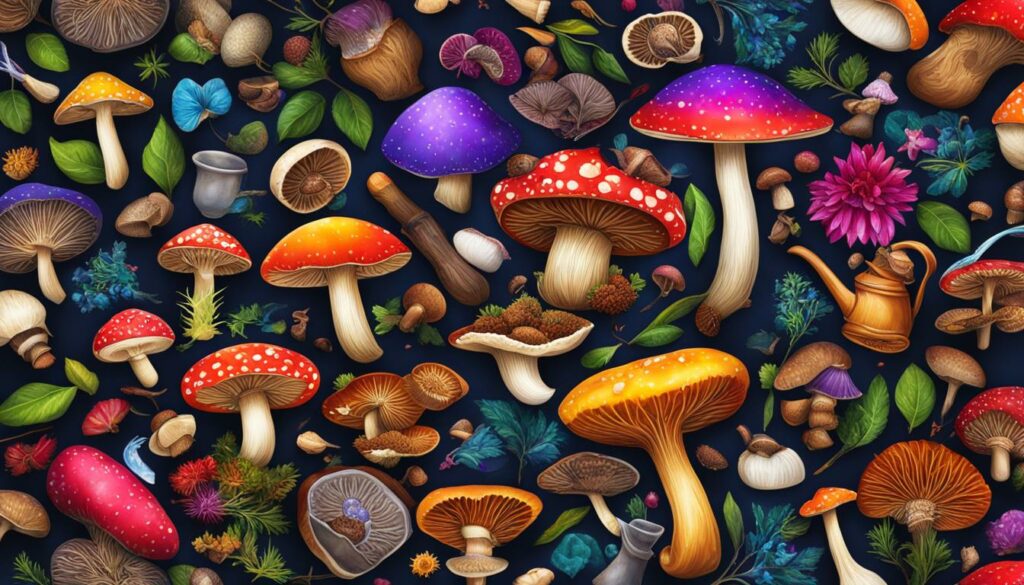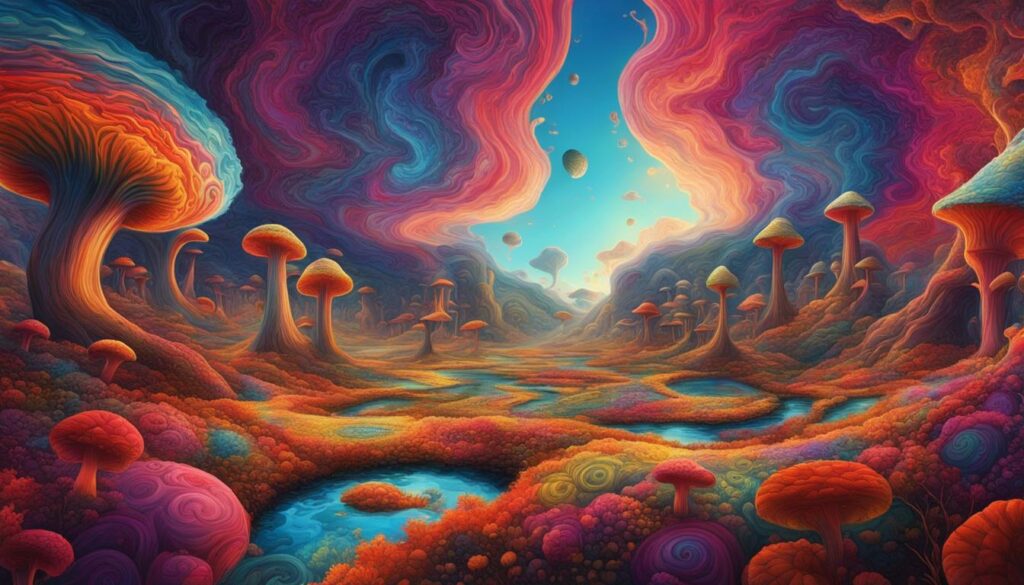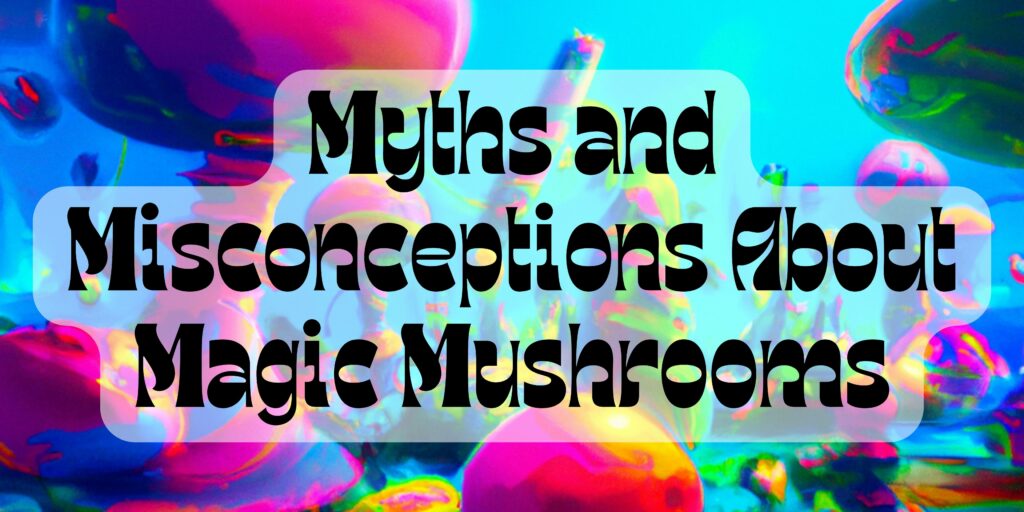Welcome to our essential guide to understanding shrooms symptoms. Whether you’re curious about the psychedelic mushroom effects, magic mushroom side effects, or hallucinogenic mushroom symptoms, this guide will provide you with the information you need to make informed decisions.
Shrooms, also known as magic mushrooms, are a group of fungi that contain psilocybin, a naturally occurring psychedelic compound. When ingested, psilocybin is converted into psilocin, which interacts with serotonin receptors in the brain, leading to hallucinations, altered perception, and changes in consciousness.
Short-term effects of shrooms include euphoria, visual and auditory hallucinations, altered sense of time, and spiritual experiences. However, long-term use can have potential consequences on mental health, such as alterations in brain chemistry, the development of Hallucinogen Persisting Perception Disorder (HPPD), and the occurrence of flashbacks.
Physical effects of shrooms are generally minor and include dilated pupils, elevated blood pressure, increased heart rate, nausea, and heightened perspiration. It’s important to approach shroom use with caution, particularly for those with pre-existing mental health conditions.
Key Takeaways:
- Shrooms contain psilocybin, a naturally occurring psychedelic compound.
- Short-term effects of shrooms include euphoria, hallucinations, altered perception, and spiritual experiences.
- Long-term use of shrooms can have potential consequences on mental health and may lead to alterations in brain chemistry, HPPD, and flashbacks.
- Physical effects of shrooms are generally minor and include dilated pupils, increased heart rate, and nausea.
- Caution should be exercised when using shrooms, especially for individuals with pre-existing mental health conditions.
The Physical Effects of Shrooms
When it comes to the physical effects of shrooms, they are typically mild but can still be noticeable. One of the most common physical reactions to shroom use is dilated pupils. Psilocybin, the active compound found in magic mushrooms, affects the muscles in the eyes, causing the pupils to expand. This can result in a distinct visual change and can be a telltale sign of shroom use.
Additionally, shroom use can lead to an increase in heart rate. The psychedelic properties of psilocybin can stimulate the cardiovascular system, causing the heart to beat faster. This rise in heart rate is usually temporary and subsides as the effects of the shrooms wear off.
Heightened perspiration is another physical effect that some individuals may experience when using shrooms. As the body’s temperature regulation system reacts to the psychedelic compound, it can cause an increase in sweating. However, this effect varies from person to person and may not be present in everyone who consumes shrooms.
Lastly, nausea is a commonly reported physical side effect of shroom use. The ingestion of psilocybin mushrooms can irritate the stomach lining, leading to feelings of queasiness or even vomiting. It’s important to note that this effect tends to be more common when shrooms are consumed raw, and can be mitigated by cooking or brewing the mushrooms into a tea.
| Physical Effects of Shrooms |
|---|
| Dilated pupils |
| Increased heart rate |
| Heightened perspiration |
| Nausea |
It’s important to remember that these physical effects are generally temporary and subside as the effects of shrooms wear off. While they can be uncomfortable, they are typically considered minor side effects of the emotional intensification caused by shroom use. If you experience any physical discomfort or have concerns about your physical health, it’s always best to consult a healthcare professional.
Psychological Effects of Shrooms
When it comes to the psychological effects of shrooms, long-term use has been associated with potential alterations in brain chemistry and the development of Hallucinogen Persisting Perception Disorder (HPPD). Regular consumption of psilocybin, the active compound in magic mushrooms, can impact the serotonin system, which plays a vital role in regulating mood, emotions, and cognitive functions.
HPPD is a condition characterized by perceptual changes that persist for weeks or even months following the use of psilocybin and other psychedelics. While relatively rare, flashbacks can also occur, which involve the sudden reoccurrence of intense sensory perceptions or emotions associated with past psychedelic experiences.
Prolonged mushroom use can have a range of psychological side effects, including increased anxiety, depression, symptoms resembling psychosis, and alterations in personality and behavior. It’s important to approach shroom use with caution, especially for individuals with pre-existing mental health conditions.
Short-Term Effects of Shrooms
When it comes to the short-term effects of shrooms, users can expect a powerful and intense experience. The ingestion of psilocybin mushrooms can induce a variety of effects on perception, cognition, and emotions. One of the most commonly reported effects is a feeling of euphoria, a sense of intense happiness and well-being. This euphoria is often accompanied by altered perception, where colors may appear more vibrant, shapes and patterns may seem distorted or morphing, and auditory hallucinations can occur.
The altered perception caused by shrooms can make time seem subjective, with users experiencing a distorted sense of time passing. This can be accompanied by a sense of connectedness with the universe and feelings of enhanced spirituality. Alongside these perceptual changes, users may also undergo intense emotional states, ranging from intense happiness and joy to sadness or anxiety. The emotional effects of shrooms can be unpredictable and vary from person to person.
It’s important to note that the short-term effects of shrooms are temporary and typically last between 4 to 6 hours after ingestion. The intensity and duration may vary depending on factors such as the dosage, individual sensitivity, and the specific type of mushroom consumed. It’s crucial to approach shroom use with caution and in a safe and supportive environment, especially for individuals with pre-existing mental health conditions.

The short-term effects of shrooms can be summarized as follows:
- Euphoria
- Altered perception
- Visual hallucinations
- Subjective sense of time
- Feelings of connectedness and enhanced spirituality
- Intense emotional states
Long-Term Effects of Shrooms
While the short-term effects of shrooms are often discussed, it’s important to also consider the potential long-term consequences of their use. Prolonged shroom use has been associated with alterations in personality, both positive and negative. Some individuals report increased openness, creativity, and spirituality as a result of their experiences with psilocybin mushrooms. However, others may experience heightened impulsivity and difficulties in social functioning.
Additionally, there is a potential for addiction with long-term shroom use. Although psilocybin mushrooms are not typically associated with physical dependence, individuals may develop a psychological compulsion to use them as a means to recreate desired experiences or cope with emotional challenges. This addiction potential underscores the importance of approaching shroom use with caution, especially for those with pre-existing mental health conditions.
To better understand the long-term effects of shrooms, it is essential to conduct further research and gather more comprehensive data. This will allow for a clearer understanding of the potential risks and benefits associated with their use. It is also crucial to provide support and accessible resources for individuals who may be struggling with the long-term effects of shroom use.
| Long-Term Effects of Shrooms | Positive Effects | Negative Effects |
|---|---|---|
| Alterations in Personality | Increased openness, creativity, spirituality | Heightened impulsivity, difficulties in social functioning |
| Addiction Potential | N/A | Psychological dependence, compulsion to use |
It is important to note that individual experiences with shrooms can vary greatly, and the long-term effects may differ from person to person. It is crucial to approach shroom use with caution and be aware of potential risks.
Summary
- Long-term shroom use can lead to both positive and negative alterations in personality.
- Positive effects may include increased openness, creativity, and spirituality.
- Negative effects may manifest as heightened impulsivity and difficulties in social functioning.
- There is a potential for addiction with long-term shroom use, emphasizing the importance of caution and proper support systems.
Risks and Safety Precautions
When considering the use of shrooms, it’s important to be aware of the potential risks involved. While psilocybin mushrooms are considered to be one of the least toxic drugs, there can still be psychological risks associated with their use. Some of these risks include anxiety, panic attacks, paranoia, mood swings, and the development of Hallucinogen Persisting Perception Disorder (HPPD).
Fortunately, there are safety precautions that can be taken to help mitigate these risks. It’s crucial to be well-informed about the proper dosage, effects, and potential risks associated with shrooms. Starting with low doses can help minimize the intensity of the experience, allowing for a more manageable and controlled trip. Additionally, being in a safe and comfortable environment, with a trusted person present, can provide the necessary support and reassurance during the shroom experience.
For individuals with pre-existing mental health conditions, it’s especially important to exercise caution when considering shroom use. The hallucinogenic effects of shrooms can potentially exacerbate existing mental health symptoms and lead to negative experiences. It’s crucial to consult with a healthcare professional before using shrooms if you have a history of mental health issues.
| Risks of Shroom Use | Safety Precautions for Shroom Use |
|---|---|
| – Anxiety | – Start with low doses |
| – Panic attacks | – Be in a safe and comfortable environment |
| – Paranoia | – Have a trusted person present |
| – Mood swings | – Consult with a healthcare professional for pre-existing mental health conditions |
| – Hallucinogen Persisting Perception Disorder (HPPD) |
“Starting with low doses can help minimize the intensity of the experience, allowing for a more manageable and controlled trip.”
By taking these safety precautions and being aware of the potential risks, individuals can have a safer and more positive experience with shrooms. It’s important to approach shroom use with caution and always prioritize personal well-being and mental health.
How Are Magic Mushrooms Taken?
Magic mushrooms can be consumed in various ways, allowing individuals to choose a method that best suits their preferences. Some common methods of magic mushroom consumption include:
- Oral ingestion: The most popular method is to eat the mushrooms directly. They can be either fresh or dried. Fresh mushrooms can be added to food, such as pizza or pasta, to mask the taste. Dried mushrooms are often consumed on their own or mixed with other foods.
- Tea preparation: Magic mushrooms can be brewed into a tea by boiling them in water. This method is chosen by those who prefer to avoid the texture and taste of consuming raw mushrooms. The tea can be flavored with honey or other additives to improve the taste.
- Smoking: In some cases, dried magic mushrooms can be crushed and mixed with cannabis or tobacco and smoked. This method can produce a faster onset of effects but is less common due to the strong taste.
- Capsules: Dried mushrooms can also be ground into a powder and placed in capsules for easier consumption. This method is preferred by those who do not enjoy the taste or texture of mushrooms.
It is important to note that injecting magic mushrooms intravenously is extremely dangerous and should never be attempted. This can lead to serious health risks and complications.

Table: Overview of Magic Mushroom Consumption Methods
| Consumption Method | Description |
|---|---|
| Oral Ingestion | Eating fresh or dried mushrooms directly or incorporating them into food. |
| Tea Preparation | Brewing magic mushrooms in hot water to create a flavored tea. |
| Smoking | Crushing dried mushrooms and smoking them with cannabis or tobacco. |
| Capsules | Grounding dried mushrooms into a powder and placing them in capsules for easier consumption. |
“Consumption methods for magic mushrooms vary, allowing individuals to choose the method that best suits their preferences.”
It’s important to remember that the effects of magic mushrooms can vary depending on the dosage, individual tolerance, and the specific strain of mushrooms consumed. Care should be taken to start with a low dosage and gradually increase if desired. Additionally, creating a safe and comfortable environment to consume magic mushrooms can enhance the overall experience and minimize any potential risks.
Conclusion
Understanding shrooms and their effects is crucial for making informed decisions about their use. While shrooms can induce short-term effects like euphoria, altered perception, and visual hallucinations, it’s important to be aware of the potential long-term consequences. Alterations in brain chemistry and the development of conditions like Hallucinogen Persisting Perception Disorder (HPPD) are possible with prolonged mushroom use.
There are risks associated with shroom use, especially for individuals with pre-existing mental health conditions. To mitigate potential risks, it is important to practice safety precautions and be well-informed about proper dosage and effects. Creating a supportive environment and seeking support when needed are also crucial.
If you have concerns about your mental health or substance use, remember that reaching out for support is always important. Understanding the symptoms and effects of shrooms is the first step towards responsible and informed decision-making.
FAQ
What are the short-term effects of shrooms?
The short-term effects of shrooms can include euphoria, altered perception, visual hallucinations, and a sense of connectedness with the universe.
Are there any long-term effects of shroom use?
Yes, long-term shroom use can potentially lead to alterations in brain chemistry, the development of Hallucinogen Persisting Perception Disorder (HPPD), and changes in personality and behavior.
What are the physical effects of shrooms?
The physical effects of shrooms can include dilated pupils, increased heart rate, heightened perspiration, and nausea.
Are there any risks associated with shroom use?
Yes, some potential risks of shroom use include anxiety, panic attacks, paranoia, mood swings, and the development of HPPD. It’s important to be well-informed and practice safety precautions.
How are magic mushrooms taken?
Magic mushrooms can be eaten fresh, cooked, brewed into a tea, or smoked. They should never be injected intravenously.




